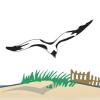"I don't understand grown men who are jazzed by bird watching” – Dave “Fredman” Frederick, People in Sports column, June 14 edition.
I regard Dave Frederick as one of the most engaging writers on the Cape Gazette staff. I was pleased to see he invoked the subject of bird watching, even if it was only a segue to an Orioles game.
Although bird watching is not what Fredman does, many people do. I am a grown man who is excited by and spends lots of time and money on bird watching. My wife is a grown woman who does the same. We have many friends of both sexes, most of whom are fully grown, in Lewes, Rehoboth, Sussex County, Delaware, all over the USA and the world who are similarly engaged.
Why birds and birding?
Birds are accessible, visible, diverse, engaging and beautiful. Birding can be as casual as watching starlings in the backyard or as engaging as the U.S. diplomat who recently set the world record of 10,000 species observed.
My wife and I are entertained for hours by the birds in our yard. We have observed 98 species, starting with a red-headed woodpecker several days after we moved in and ending with a yellow warbler in a bird bath in May 2024. Our Delaware life list is at 294, mostly observed since we moved here in March 2016 but supplemented by a trip to Bombay Hook National Wildlife Refuge in August 1976 with our infant daughter.
Many birds are strikingly beautiful, and most are subtly stunning. Scarlet tanager is a common breeding bird in Delaware's mature forests. It is a deep, scarlet red with midnight black wings. I take great pleasure in locating a singing tanager and pointing it out to someone who has never seen one. Invariably, they cannot believe their eyes.
Why is birding important?
Wildlife watching accounts for literally billions of dollars spent in the U.S. on optics, gear, clothing, travel, lodging, meals and guides. Just learning the names of the 429 species of birds possible in Delaware, let alone plumages for males, females, young, winter, breeding and different life stages can be a lifelong effort. Any half-serious birder gains broad knowledge of habitats, topography and geography. In Delaware, we are blessed with the Atlantic Ocean, Delaware River and Bay, fresh and salt marshes, oak and pine coastal plain forest, piedmont deciduous forest and extensive agricultural land. This habitat diversity contributes to our outstanding bird diversity.
Many birders now use the website and smartphone app eBird, free from the Cornell Laboratory of Ornithology. Observations submitted to eBird form the basis for almost priceless contributions to our knowledge of the environment and how it is changing. More than 54 million complete checklists have been submitted by citizen scientists for the U.S. since its inception.
Fredman, maybe I could even get you jazzed by a morning spent bird watching around Sesame Street by the Sea or by photographing birds other than Eagles or Orioles.






















































